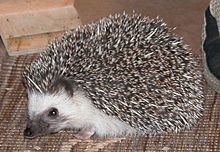Four-toed hedgehog
| Four-toed hedgehog[1] | |
|---|---|

| |
| Scientific classification | |
| Domain: | Eukaryota |
| Kingdom: | Animalia |
| Phylum: | Chordata |
| Class: | Mammalia |
| Order: | Eulipotyphla |
| Family: | Erinaceidae |
| Genus: | Atelerix |
| Species: | A. albiventris
|
| Binomial name | |
| Atelerix albiventris (Wagner, 1841)
| |

| |
| Range of A. albiventris | |
The four-toed hedgehog (Atelerix albiventris), also known as the African pygmy hedgehog, is a species of hedgehog found throughout much of central and eastern Africa.
Populations tend to be scattered between suitable
There are no universally agreed subspecies of A. albiventris.
Description

The four-toed hedgehog is an oval bodied animal approximately 210 millimetres (8.3 in) in length and weighing between 250 and 600 grams (8.8 and 21.2 oz).
It can vary greatly in colouration, but typical wild specimens have brown or grey spines with white or cream colored tips. The fur on the body is speckled grey in color, with brown around the muzzle, and white face, legs, and underparts. The upper body is covered in spines varying from 0.5 to 1.7 centimetres (0.20 to 0.67 in) in length, being longest on the upper surface of the head. The spines are variably colored, but always have a white base and tip.[4]
Males have an externally visible penis, located in the mid-abdomen, but the testicles are recessed into pouches close to the anus.[6] Females may have anything from two to five pairs of teats.
Distribution and habitat
The four-toed hedgehog is found across a wide swathe of central Africa, from
The main predators of four-toed hedgehogs within their natural habitat are Verreaux's eagle-owl, jackals, hyenas, and honey badgers.[4]
This species tends to prefer temperatures between 24 and 30 °C (75 and 86 °F). When it is hotter than that, it tends to find shelter in a burrow and go into a state of
Behaviour
The four-toed hedgehog is a solitary,
The most common sounds made by four-toed hedgehogs are snorts, hisses, and a quiet twittering sound. When attacked, the animal can scream loudly, and males also produce a birdlike call during courtship.[7]
Although four-toed hedgehogs do aestivate through the summer, this is not thought to be connected to a rise in temperature, but rather to a lack of available food. Aestivation rarely lasts for more than six weeks.[4]
When encountering a predator, its standard defensive reaction is to tense up all the muscles on its back to cause its spines to stand erect, and then roll into a ball protecting its limbs and head. If it is harassed further, it will twitch in an attempt to jab spines into the predator and make snuffling/grunting noises.[4] Its spines are not released into the skin of an attacker, as those of a porcupine. Hedgehogs only rarely lose quills during adulthood; heavy quill loss is usually a warning sign as to the animal's health.[8]
When the four-toed hedgehog is introduced to a new or particularly strong smell, it will sometimes do what is referred to as self-anointing. It creates a large amount of foam by combining the aromatic substance with its saliva, and spreads it onto its spines. The purpose of this behavior is poorly understood, but it is thought to be a defensive action, as hedgehogs have been known to self-anoint with poisonous toads.[4]
Reproduction

Female four-toed hedgehogs do not go into
Gestation lasts thirty to forty days, and the mother gives birth in a well-lined nest cavity, such as an abandoned rodent burrow. The young are covered in a thin membrane to protect the mother from their already present spines, though it takes them some time to gain control over the muscles that move them. At birth, the young weigh about 10 grams (0.35 oz), and are blind and helpless, with only soft spines and no other fur. The spines stiffen within a few hours, and further spines emerge over the first few days of life as the skin, initially swollen and edematous, begins to dry and contract.[4]
The eyes open at fifteen days, when the young begin to become more active. The deciduous teeth appear at about three weeks, with the permanent teeth following at seven to nine weeks. The young are weaned by six weeks and leave the mother not long after. They can become sexually mature at two to three months of age, although in the wild they will not typically breed during the first year of life.[4]
In the wild, four-toed hedgehogs live for no more than about three years, but they have lived up to ten years in captivity.[9]
In captivity
This section needs additional citations for verification. (May 2022) |
The four-toed hedgehog is one of the most popular species of
References
- OCLC 62265494.
- ^ Hutterer, R. (2008). "Atelerix albiventris". IUCN Red List of Threatened Species. 2008. Retrieved 30 August 2009. Database entry includes a brief justification of why this species is of least concern.
- ^ https://www.ajol.info/index.php/ari/article/view/187110/176386.
{{cite news}}: Missing or empty|title=(help) - ^ doi:10.1644/857.1.
- ^ Allen, J.A. (1922). "The American Museum Congo Expedition collection of Insectivora" (PDF). Bulletin of the American Museum of Natural History. 47 (1): 1–38. Archived from the original (PDF) on 2007-07-05. Retrieved 2010-11-02.
- PMID 11006156.)
{{cite journal}}: CS1 maint: DOI inactive as of March 2024 (link - ^ ]
- ISBN 9780764144394.
- PMID 11222009.
- ^ Doss, Grayson A (2021-06-23). "Diseases of Hedgehogs - Exotic and Laboratory Animals". Merck Veterinary Manual. Retrieved 2022-04-12.

